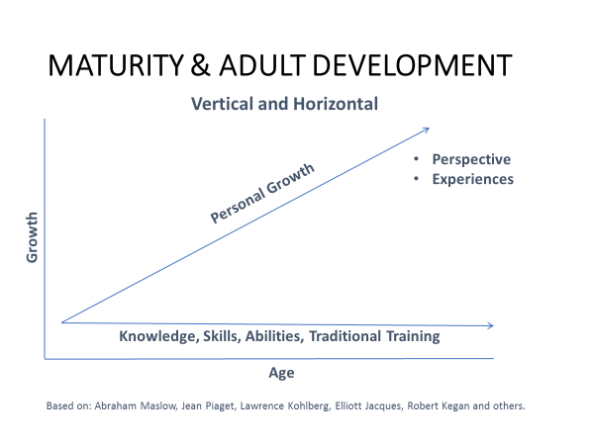In the previous blog posts, I discussed how to understand the ‘whole person’ and the first levels of Leadership Maturity. If you have not read those, please go to www.tonyleng.com as this blog post builds on the previous ones.
Maturity Level 4:
At ML4, you take ownership of your life and become ‘self-authored.’ The average age for ML4 is around 44 – you can get there by age 35, but it may take until age 55 or later – depending on how quickly you have matured. By ‘self-authored,’ I mean that you have decided who you are.
At ML3, you were constantly looking outward for validation and decision making, things were ‘done to you,’ and you didn’t really take responsibility for your actions/reactions. At ML4, is it not where you are leading ‘to,’ it is where you are leading ‘from.’ Today, the ‘to’ is constantly changing as businesses rise, change, and adapt to meet challenges, and if your team is to follow you, they need to know you are authentic – that your values are integrated into your identity.
When ML4 leaders makes decisions, they look ‘inside,’ not ‘outside.’ It is not about, “What would so-and-so (boss, affiliation group etc.) say?” Instead, it is, “How can I look at myself in the mirror after making that decision?” ML4 typically comes across as gravitas – leaders know who they are, what they stand for, and are able to communicate that.
ML4 leaders set the vision, they self-initiate, and self-correct along the way. They are concerned with goals, standards, and objectives. They also show compassion for others without owning their well-being. Whereas, at ML3, we are so concerned about making the other person feel okay or good that a tough decision about having to let someone go is incredibly stressful or hard – see the ‘effectiveness transition’ in the prior blog post.
ML4 leaders know how to delegate – they grant others autonomy and help them grow. They use feedback to RE-fine who they are — not DE-fine who they are. At ML3, tough feedback can be devastating because it challenges who they are because they determine their sense of worth from outside reference points. But at ML4, the thinking typically goes like this: ‘Mmm, that part of the feedback is valid and useful, so I will work to up my game in that area, but the other stuff is probably more a reflection of the individual giving the feedback, so I am going to listen, be polite, and file it away.’
ML4 leaders are secure enough to listen to input from others, and confident enough to make decisions. They are OK with conflict and encourage constructive dialogue en route to a good decision. Here are a few typical things you will hear ML4 leaders say: ‘The buck stops with me.’; ‘That is something I am not willing to do – we are going to do the right thing.’; ‘Let’s agree to disagree.’
By now you hopefully recognize yourself – and can peg where you are. I do, however, want to make a few points clear:
- The journey is not linear. You move up and down on the line. I sometimes have ML3 ‘moments’ when someone says something hard to me, but I can recognize that and then move back to where I should be. This is normal.
- People mature at different rates. You can have a 35-year-old ML4 individual and a 55-year-old ML3 individual. Age does play a role, but life experience and how you interpret and deal with those experiences drives maturity. It is important to reflect on your life journey and how it has matured you. I often ask candidates to discuss a failure or hardship, either at work or personally – e.g. getting fired, huge work failures, divorce, being let go (laid off), losing a loved one, etc. – asking how they viewed ‘people and things’ before and after that event, and if they noticed a difference.
- Your position may not define your level. I have met bosses at ML4 who have EA’s at ML5!
Some final thoughts on ML4:
- It is where most C-level executives operate from – and is a great place to be.
- You have developed an internal GPS – you know how to ‘get stuff done.’ You are confident, effective, a good leader, and have gravitas. You plug the destination desired into your internal GPS and it gets you there.
- At ML4, you are successful. You have probably made good money, have a great EA who keeps the hordes at bay, belong to some great clubs/societies, live in an exclusive community, and hang with other powerful and successful people.
- But there is a trap. You are in an echo chamber and tend to screen out those ‘uncomfortable, dissident voices/trends’ – which would help you get to ML5.
- ML4 leadership thinkers move to ML5 when they realize the inadequacy of their current understanding and start taking a more objective view of themselves and their current paradigms.
- An older ML4 person often shows up as a ‘grumpy old man/woman,’ stuck in his or her ways, and lamenting at how bad things are getting. They are not ‘open.’
Now I have you curious about ML5, I will discuss the attributes regarding ML5 in my next blog post.
(Note: If these notes on Maturity intrigue you and you want to go deeper, I recommend Keith Eigel’s pioneering work in his book, The Map, and his work at The Leaders Lyceum, from which I draw much of this content.)

